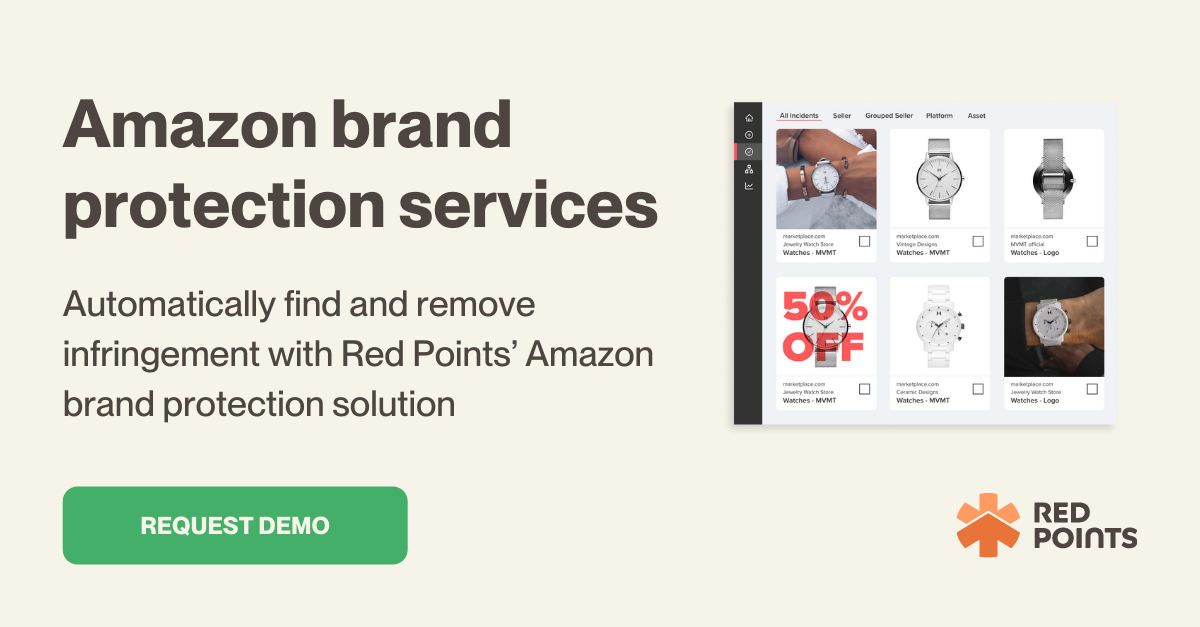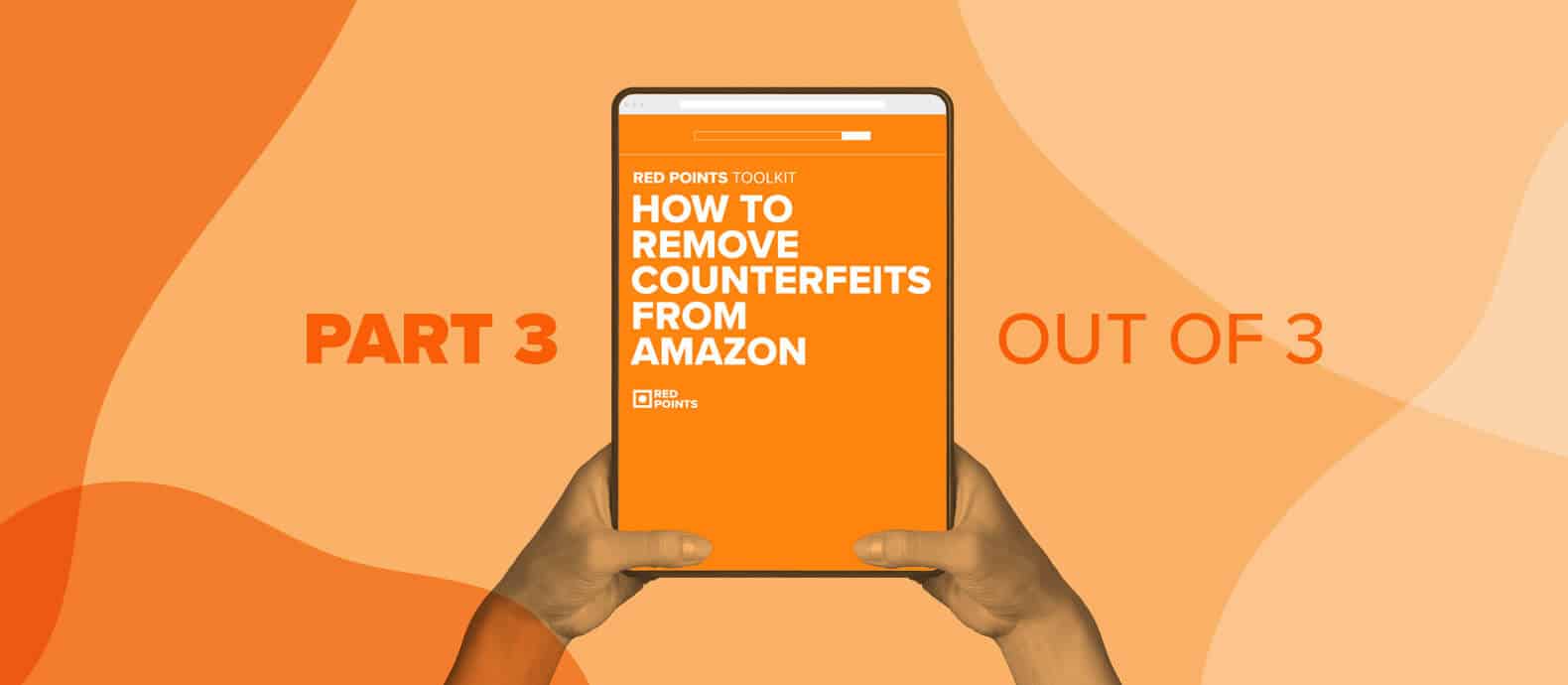Today, many businesses use Amazon as a vital source of revenue. There are currently 9.7 million sellers operating on Amazon, with over 150,000 of those each generating more than $100,000 in annual sales. At the same time, businesses are starting to receive more competition from third-party sellers on Amazon listing identical or very similar products.
This gray market practice has the potential to ruin the revenue streams of legitimate businesses. So, how can your business avoid third-party sellers on Amazon and safeguard revenue from unauthorized sellers?
In this blog, we’ll be exploring how to avoid third-party sellers on Amazon listing your products by highlighting a number of topics, including:
- Understanding the threat of third-party sellers to your business
- How to avoid third-party sellers on Amazon
- How can Red Points help your brand avoid third-party sellers on Amazon
Understanding the threat of third-party sellers to your business
The threat of third-party sellers is real. Many businesses that operate on Amazon may have stumbled across listings that look identical to their own product listings. These will have been created by sellers who are seeking to take advantage of the popularity of larger brands and products to sell their own versions of new and used products.
What are third-party sellers?
- Third-party sellers are independent sellers who use marketplaces like Amazon to sell directly to consumers. The products they are selling are often a variety of new, used, and refurbished items. Amazon generates billions of dollars in sales from third-party sellers. They’re a key group for Amazon but they present a challenge to brands trying to sell original products online.
- Not all third-party sellers present a threat to business. Some third-party sellers use Amazon to sell their own unique products that in no way undermine, undercut or steal from legitimate businesses. However, the main problem with third-party sellers is when they engage in the unauthorized selling of products that in some way use another brand’s intellectual property (IP).
- What about drop shipping? Drop shipping is a form of retail in which businesses accept orders without keeping stock on hand. Instead, the seller will only purchase inventory when necessary from a third party to fulfill the customer’s order.
Drop shippers operate on Amazon and they essentially function as the middleman between the manufacturer and the consumer. It is different from the standard retail model because the drop shipper doesn’t own any inventory or stock.
The threat of unauthorized resellers
Third-party sellers that engage in unauthorized reselling of your products can have a significant negative impact on your profits. For example, unauthorized resellers are able to operate freely on popular online marketplaces like Amazon, it may be difficult for consumers to find your product.
Equally, if there are many alternative versions of your product sold at different price points then the consumer will likely opt for a cheaper version even if it isn’t sold by the original company that created the product.
If you fail to take action to protect your brand from unauthorized sellers you will find that your revenue, reputation, and connection with consumers all suffer.

How to avoid third-party sellers on Amazon
To mitigate the impact of third-party sellers on Amazon there are a few key steps you need to take:
- Establish an authorized seller network
Establish connections with other authorized sellers on Amazon. This will help you create a network of legitimate sellers – allowing you to protect your revenue and keep tighter control over who can and cannot sell your products on Amazon. With an authorized seller network, you will also have greater visibility of potential weak points on Amazon and areas where you may be vulnerable to unauthorized sellers.
- Leveraging Amazon’s Brand Protection tools
Amazon’s Brand Registry program is a simple way to protect your brand on Amazon. This tool in particular allows you to safeguard your intellectual property and manage the accuracy of your listings.
You can also use Amazon’s Transparency program to authenticate your products using securing, unique codes that identify individual units and limit the proliferation of counterfeits. Within this program, you can engage with customers post-purchase which will help you crack down on authorized third-party sellers and create real connections with your online customer base.
The final resource within Amazon’s internal system is Project Zero, which combines the power of Amazon’s technology and brand insights to detect and remove counterfeits.
- Monitoring and enforcing your intellectual property rights on Amazon
To mitigate the impact of third-party sellers on Amazon it is vital that you continue to monitor and enforce your intellectual property rights within the marketplace. You can do this by manually searching for and reporting unauthorized sellers.
However, it is more efficient to use the programs built-in into Amazon’s system, like Project Zero and the Brand Registry, which are tailored to deal with intellectual property cases and product listing management.
How can Red Points help your brand avoid third-party sellers on Amazon
Beyond using Amazon’s own tools, your business will also benefit from engaging with specialized external programs like Red Points’ Amazon Brand Protection Service. We help thousands of businesses automatically find and remove infringing content and listings on Amazon with three simple steps:
- Monitor and detect
Our automated bot-powered search allows us to quickly identify cases of trademark, patent, and brand infringement based on your registered intellectual property. Our detection process runs 24/7 and uses image recognition technology to scan Amazon listings to spot unauthorized resellers.
This helps us find cases of copyright infringement whereby bad actors use official product images and potential trademark infringement, where your logo(s) or other trademarks are being used unlawfully.
- Review and validate
We collect any detected cases of potential infringement into a log for you to review and validate. Within our digital workspace, you can easily and quickly find high-priority cases and validate their infringement status. You can also automate this process based on the validation rules that you set up. Every step of the process is geared towards efficiency and precision to ensure that you can protect your brand on Amazon at all times.
- Enforce and take down
Red Points will then carry out all enforcement of your intellectual property rights on your behalf and take down infringing listings that you have validated.
Our efficient system and experienced team have helped us achieve a 91.4% enforcement success rate across all Amazon domains as well as an average takedown time of 1.5 days. So you can rest assured that Red Points will help you mitigate the impact of third-party sellers on Amazon.
What’s next
If you want to avoid third-party sellers on Amazon taking advantage of your brand you have to be proactive and informed. Once you understand the threat third-party sellers pose to your business you can then start to take steps to safeguard your revenue, your brand, and your customers.
By registering your product to Amazon’s Brand Registry program and leveraging Amazon’s tools to combat unauthorized listings you can start to protect your brand from infringements. If you’re looking to elevate your Amazon brand protection or need assistance with a large-scale issue, discover how Red Points can help.







